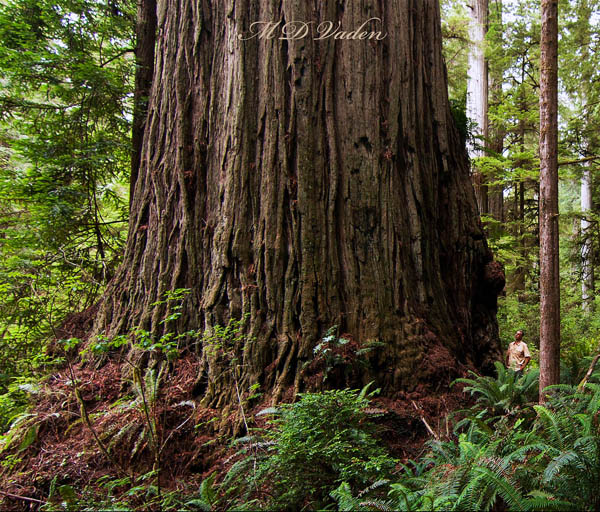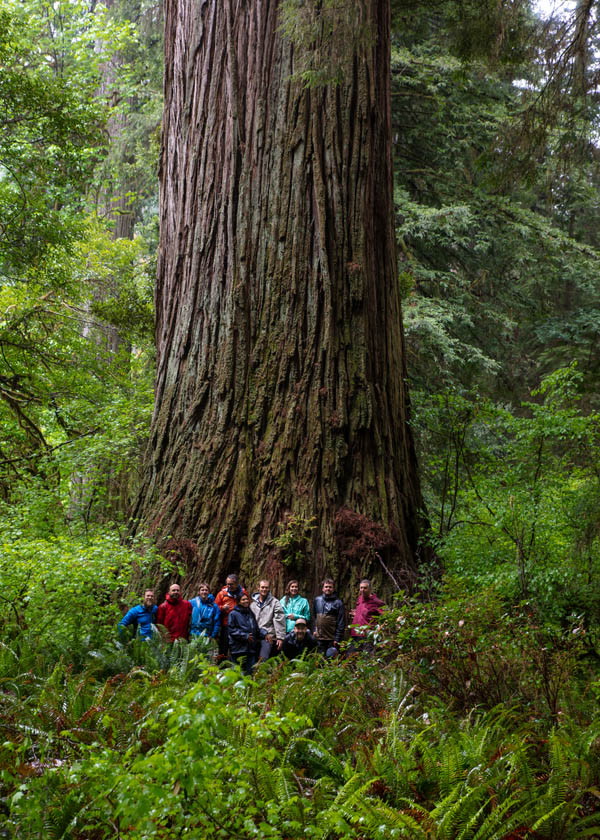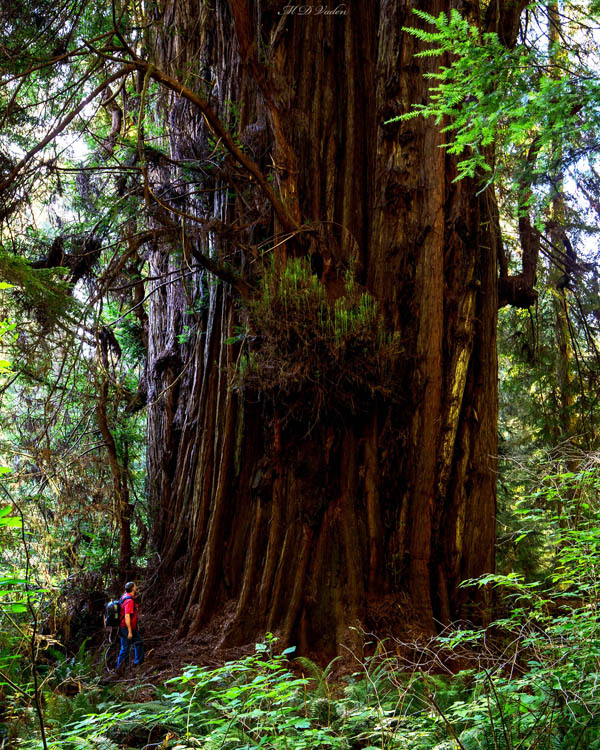By Mario D. Vaden
ISA Certified Arborist PNW-5584A
This page is presented as a Certified Arborist Report incorporated into a written article.
Coast redwood species may be the new “giant Sequoia” of this millennium. And to simply facts, that’s its genus name – Sequoia sempervirens
In recent years Sequoiadendron sort of got nudged by coast redwood in the realm of new discoveries. And coast redwood is definitely taller, wider and apparently scores more measuring points than Sequoiadendron on the American Forests or other state registries.
Big Tree registries have become a less useful “tool in the drawer” and several of us quit nominating trees. But if new coast discoveries were nominated, the overall national champ at American Forests’ registry would be two or more coast redwoods. Notes about measuring points are on The Big Kahuna page
(Sequoidendron’s so-called “single trunk” mass champ is questionable but may be impossible to ascertain even if DNA was tested. It’s being a single bole has basically been assumed over the years. That aspect is discussed in some detail at another page “Seen a Tree?“)
Between 2000 and 2017, enough massive coast redwoods were discovered for the coast species to more closely fit the confusing “giant Sequoia” common name used for the Sierra Nevada genus Sequoiadendron. If the coast genus exceeds the mountain genus for height, points, width and girth, how can the mountain genus be a GIANT version of the coast’s Sequoia genus? It’s as confusing as calling Dodge RAM a “Giant Silverado”.
The entirety of discoveries and photos haven’t been fully published but Sequoia sempervirens (coast redwood) has specimens 70 ft. taller and greater diameter than any known Sequoiadendron, and with comparable volume.
Setting aside 1, 2 or 3 individual Sierra Nevada trees, coast redwoods are virtually the same size as Sequoiadendron based on trunk measurements.
The new discoveries are a realization that coast redwood has probably been the widest species in the USA for decades. A few people have trouble accepting this fact saying things like “there’s nothing on public record”. But Save the Redwoods League (STRL) confirmed the DBH diameter online, so there is a public record. STRL may be the most outstanding name in redwood country.
To some who rely on a few sources like the National Park Service, Redwood National Park or rangers as a point of reference, you may come up dry on some recent facts or discovery. But consider that several years ago the Statesman Journal ran a news story for fund raising and coast redwoods. The writer quoted scientist Dr. Sillett of Humboldt State University with this:
“We now know of larger trees elsewhere,”
Context denotes coast redwoods. What are these larger trees elsewhere? How big? How wide? The article does not say. But if Dr. Sillett says something exists, it exists. Don’t just rely on the park service or Wikipedia to validate facts. Utilize experts with the proven reputation for discovery and measuring like Michael Taylor & Chris Atkins (The Wild Trees, 2007), Ron Hildebrant or others they collaborate with like Zane Moore.
To cover diameter for a moment, the widest known tree in the USA was encountered October 9, 2010, bushwhacking with Thomas Hahn (of Germany) in Redwood National and State Parks, but we had not measured hoping to return another year. We refer to the tree as “Capt. Jack Sparrow”. John Montague of Arcata encountered the same coast redwood in 2015 and was first to recognize, measure and discover its diameter. John calls it “Jupiter”. The diameter was 29.2 feet @ dbh and it is also wider at ground level making it a diameter record for ground level and “footprint” size. We have not published its photo but the 27.34 ft. dbh coast redwood below is the sample I utilize to convey what this kind of girth looks like. Zane Moore also measured. Zane is a researcher and Plant Biology PhD student at UC Davis. His name may be familiar to people who follow (NPR / Washington Post) his albino redwood research with Thomas Stapleton. And John is an experienced measurer of redwoods and board member of Save the Redwoods League who collaborates with Michael Taylor (co-discoverer of world’s tallest tree).
Chris Atkins (world-class tree measurer) has also been to this Capt. Jack Sparrow redwood. So there’s no fog of debate. The tree and measurements are established verified fact. Updated fact sources or news releases are very rare. No parks seem to mention the discovery. Save the Redwoods League notes it discretely among other facts.
- Save the Redwoods League Facts Page
- Lost Coast Outpost / Local Man May Have Just Found the World’s Fattest Redwood.
- Avenue of the Giants: Discovery of the Fattest Redwood
- Redwood Coast Parks Travel Guide
- ENTS forum May, 2015 / New dbh Champ for SESE
More information is provided on the New Discovery Page. The photo below is provided to offer a peek into the potential of new discoveries; a coast redwood trunk clearly wider side to side than most Sequoiadendron including General Sherman. The person is not standing behind the 309 ft. tall trunk to exaggerate but toward the middle front to accurately convey the size. It’s worth noting that the coast redwood below exceeds Gen. Sherman’s diameter dbh and equals or exceeds Gen. Grant’s diameter 60 feet above ground.
Continue reading below:
(Note: the coast redwood shown is estimated over 4000 yrs. That age estimate is based on meticulous ring counts of 8 fallen redwoods with at least 3000 rings each. Those were all about 1/2 the size and diameter, counted by Ron Hildebrant (collaborator of Taylor and Atkins). So even 4000 yrs. may be conservative)
For botanical classification, coast redwood was temporarily called Taxodium sempervirens around 1824. But a botanist Stephan Endlicher fine-tuned the name to Sequoia sempervirens in 1847, etching the name in stone. During that time, even if nobody realized yet, coast redwoods existed much bigger than any Sequoiadendron we have ever seen or photographed. Those coast redwood titans included the Crannell Creek Giant and Lindsey Creek Redwood
Sequoiadendron up in the Sierra Nevada wasn’t discovered until 1833, apparently by the Walker expedition. In years following, it was named Sequoia giganteum. The name was incorrectly applied, because Endlicher had already used that name previously for a horticultural variety of coast redwood. Afterward, the mountain species was revamped to Sequoiadendron gigantea
Continue reading below …
200 years of history establish that coast redwood is the one and only Sequoia. Historically, Sequoia sempervirens grew some largest trunks known, which eventually fell. But gigantic specimens are also known to exist today. All things considered, Sequoiadendron does not have anything big enough anymore to earn coast redwood’s genus name for a common name.
If the average person stood in front of the largest coast redwood, then traveled and stood in front of the largest Sequoiadendron, they probably couldn’t tell which was really the largest if they were not tipped-off in advance. Even though the largest coast redwood is taller, I doubt they could tell which one was the tallest either.
Presently, the name for Sequoia National Park makes no sense, and often causes confusion about the two evergreen redwood species. It reminds me of another name mix-up of wood called “cedar” fence boards from a Thuja genus evergreen with a common name western cedar or western redcedar. But in no way is it a cedar. Thuja plicata has “sprays” of scale-like flattened folliage and tiny cones that open and fall, like like little brown tulip petal shapes. Meanwhile, real cedars in the genus Cedrus, have regular looking needles and fist size cones that sit upright on branches and disintegrated into scales that fall or blow to the ground. The names won’t disrupt lumber supplies but do complicate education about trees and selection of trees for landscape design.
Continue reading below …
It’s unlikely that parks will post updates about this information. Rangers in the Sierra Nevada have never seen all the new coast redwood discoveries. And the coast park rangers promote height of the species, often avoiding mention of maximum size. It’s their choice of promoting what they choose to promote. The mountain trees are promoted as big and the coastal trees are promoted as tall.
The photo shown above is just a sample. But the few images here and the discovery page should convey some idea for size of new finds.
As an extra, I posted a video of the coast redwood in the first image regarding taking photographs and movement around certain trees. Keep in mind, I’m not a videographer! See The Real Giant Sequoia … coast redwood, Sequoia sempervirens video
And may the “Forest be with You” !




Recent Comments